Disclaimer: This cartoon contains racist content and imagery presented for historical and informational purposes only. With said content being condemned, I encourage you to speak up in the case I say something ignorant or harmful--never my intent, I aim to take accountability should that occur. Thank you.
Release Date: October 7th, 1939
Series: Merrie Melodies
Director: Chuck Jones
Story: Bob Givens
Animation: Phil Monroe
Musical Direction: Carl Stalling
Starring: Mel Blanc (Birds)
(You may view the cartoon for yourself here.)
With almost a year of directing under his belt and only one star character to his name, Chuck Jones births his newest character who, surprisingly, would outlive Sniffles in terms of theatrical longevity: Inki.
Designed by Charlie Thorson, Inki was a little African hunter whose cartoons typically followed his adventures in seeking out food and escaping from predatorial wildlife. Having designed the eponymous character for Disney’s Little Hiawatha, Thorson’s designing of Inki is incredibly derivative of the aforementioned cartoon, as is the nature of The Little Lion Hunter as a whole.
Outside of his design, name (given to him in 1941 with Inki and the Lion) and general premise for the character as a whole, Inki is somewhat anomalous in that his portrayal tends to steer further from stereotypes than other cartoons with Black leads and ensembles: for one, he is mute, thus sparing him of a dialect, and much of the humor stems purely from his acting, behaviors, facial expressions, and so on rather than mocking and enabling stereotypes—something sadly rare and unique to only Inki.
Perhaps the star of his cartoons isn’t so much Inki as it is the mynah bird; a peculiar and seemingly omnipresent being whose fourth dimensional qualities were elusive to even Jones himself. Described by Jones himself as fourth-dimensional cartoons, he admitted that they “baffled” even the man he was initially attempting to mimic: “Disney would run them for his staff and say, ‘What’s so funny about these?’ If he’d brought me over, I couldn’t have told him. They were really fourth dimensional pictures, and I don’t understand the fourth dimension.”
Curiously, character designer Bob Givens is given the story credit. Givens himself conceded to the Disney influence in his storyboards, so much so that even Leon Schlesinger, who once strived to be worthy competition to Disney and “make ‘em cute”, had to step in and tell him to cut the fluff. Recalls Givens, “I was trying to make some good things out of them—fun drawings, Disney-type things,” “Leon saw me one day doing them, and he said, ‘Cut out the Rembrandt, kid. Just do a bunch of them.’”
Despite this being Givens’ only credit—which has been excised thanks to the short’s Blue Ribbon reissue in 1946—his naturally design conscious style of thinking and drawing leeches into much of the staging and composition of the cartoon itself. Keen awareness for relationships between negative and positive space, bursts of engaging perspective shots, intimate close-ups to exaggerate size and power discrepancies and so forth.
Like the vast majority of the cartoon, animation of a parrot flying in solid perspective through the jungle is scored to Mendelssohn’s "Fingal’s Cave". Carl Stalling is able to bend the same, repetitive melody to any tone necessary—comic, stoic, panicked, stealthy, inquisitive, anticipatory, and so forth. Here, the tone is noble, bold, working well in conjunction with the equally valiant animation of the parrot circling onto a low tree branch. Transitions between a horizontal pan to vertical is smooth and paced well.
Likewise with the timing of a spear piercing the tree and prompting the bird to flee in a squawking fit. Though the speed and spacing of the spear itself is somewhat even and slower than the reaction it elicits, it succeeds in its mission to catch the audience off guard and signal a deliberate interruption from the docility of the bird in its natural habitat.
Reverberations of the spear seconds continuing after the parrot has fled the scene indicates motion, inhabitance, fresh blood behind its throwing. Indeed, such is indicated as Inki slides into frame, searching for his target; from the size of the spear and intended ferocity of the throw, the audience is misled by the source. An adult hunter seems to be the obvious assumption rather than a kid.
Jones continues to keep the audience guessing by showing Inki only briefly before moving on to the next scene. A hook is therefore sunk; rather than laying out his life’s story or contextual purpose there, momentum continues to be garnered as he is teased through brief bursts—we’ll get to know him more later.
Instead, concentration is focused now on a giraffe grazing on some leaves. Staging of the scene is particularly sharp with a heavy emphasis on negative and positive space—the tree frames the giraffe, who inhabits the negative space in the right half of the screen when staring at the audience and eating. Focus is very clearly delegated to the giraffe, uncluttered by obtrusive background details.
Not only that, but the tree itself provides a visual guide when the spear pierces it in perspective, shooting in from the foreground. With the tree and backing shrubbery in mind, the screen is essentially split down the middle; the audience is provided ample time to digest both the giraffe and the spear at separate intervals and recognize the parallels in the patterns, but not in a way that feels purposefully orchestrated or mechanical.
Both sides of the screen essentially converge once the giraffe locks its teeth around the spear. Its wide eyed stare and slight pause before letting go (prompting a side effect of further reverberations from the giraffe) speaks strongly to Jones’ sensibilities, reminiscent of many a reaction take or facial expression under his guidance.
Willingness to spear a butterfly conveys overzealousness on Inki’s part, embracing that he is, in fact, a kid—his attempts at spearing various denizens of the jungle aren’t for food so much as they are attempts to prove himself a worthy hunter. Thus, Jones’ underdog motif so prevalent in his early years marches forth. As the cartoon progresses, Inki would assert himself as the underdog in more obvious and entertaining ways than hunting butterflies, but it’s a clever topper that potentially holds more insight than what lingers on the surface.
Impact lines of realization and subtle distortions on the adjoining sequence of Inki approaching a bush possibly suggest the handiwork of Ken Harris. Stalling continues to work his musical flexibility as the persisting accompaniment of “Fingal’s Cave” turns from valiant to suspended and furtive, matching Inki’s footsteps as he stalks footprints in the ground to alarmed and climactic once the bush rustles.
Intriguing perspective in both the posing of the characters and the stage directions; running diagonally across the screen and into the foreground is more engaging, dynamic, and immersive than rushing horizontally off-screen, having the camera pan slowly towards his direction, and show him peeking out from behind the tree, all on the same plane.
Likewise, continuity between beats of action is strong. Instead of cutting to a new shot of the bush, the camera merely follows the footprints back to the bush before revealing its perpetrator. The audience feels as though they are experiencing the movement for themselves, as though it is their eyes following the footprints and settling on the shrubbery rather than a manufactured camera move.
Enter one of Jones’ most curious creatures: the mynah bird. His shtick would essentially be appropriated for stronger, sharper laughs in The Dover Boys at Pimento University with an elderly man hopping across the screen, impervious to his surroundings and seemingly omnipresent. One difference between the man and the bird (outside of tone, as one senses the mynah’s debut to be interpreted as almost supernatural or mystical rather than humorously ill-fitting) lies in longevity.
The mynah’s shtick, in all of its appearances, hardly ever changed. With Hobo Bobo being the exception—one that comes somewhat logically, seeing as it was helmed by Bob McKimson rather than Chuck Jones—the mynah only exists to traipse across the screen in accordance to “Fingal’s Cave”, hardly shedding eye contact. With this in mind, he possesses a great amount of strength and inexplicable power that will be explored momentarily. He is a creation that is purposefully and wholly abstract—an abstraction so memorable that he was able to make cameo appearances in cartoons completely unrelated to Inki (Hobo Bobo) performing the same exact gait with the same exact demeanor to the same exact tune.
Inki mimicking the mynah’s gait was a further piece of continuity in the series. With tangible solidity and confident construction, Bob McKimson seems to be a strong candidate for the animator behind the shot of Inki stalking the bird. Jones employs a “surprise pan”—after lingering on a close-up of the mynah, the camera pans with little fanfare to reveal Inki galloping along in the exact same cadence.
Staging continues maintain its dynamism through conscious decisions such as having the mynah bird drop into a hole at a 3/4 angle rather than maintaining the horizontal pan. Diagonal angles typically convey motion and feel more natural compared to more static, straight or horizontal angles (which have plenty of merit in their own right.) 3/4 angles and the naturalistic appeal inherent to them accomplish Jones’ mission for lush visuals and overarching depth more than the typical vaudevillian flat staging.
Likewise with the incredibly tight close-up of Inki digging around inside the hole—having him so close to the screen feels intimate, immersive, warping the audience’s sense of scale.
His face lighting up upon finding something works well in tandem with Stalling’s musical accompaniment, which brightens up on its own accord. While the sequence is admittedly slow, it is a slowness whose meticulousness serves a functional purpose rather than trying to fill up time or be something it’s not. Jones’ penchant for shadows sculpts the character and adds the depth he strived to maintain.
The coming sequence of Inki unearthing a skunk from the hole, delicately placing it back and wiping his hands with palpable disdain was received so warmly by either the audience or Jones himself that it was reprised nearly verbatim in the next Inki cartoon, Inki and the Lion.
It doesn’t prove difficult to see why it was reused. Inki’s facial expressions towards the camera are so visceral, his movements so genuine in their motion that it wholeheartedly deserves any laughter it received. Such a maneuver is pure Jones, whether it be the facial expressions themselves or the thick pause served for the audience to chew on. Acting this human and this raw was not commonplace in 1939 Warners cartoons. While Jones attempts to take it one step further in Lion by having Inki tuck the skunk’s tail in, the simplicity of this particular example is beneficial in itself.
Elsewhere, the elasticity of Inki’s take as he spots something else off-screen is an equally nice change of pace—even the tip of the spear itself temporarily morphs into rubber to complete the distortion. Even if the take itself is somewhat slow and renders the distortions as movement that is gelatinous rather than snappy, the malleability and looseness of the motion give Inki a youthful, energetic, plucky demeanor.
His prize is revealed to be a turtle strolling about the jungle. A surprised eye take provides a means of transition between the establishment of the turtle and Inki’s attempts to spear said turtle from off-screen—having the spear fly directly beneath the turtle as he jumps with little pause rather than showing Inki taking aim again upholds a strong rhythm and sense of connection through each sequence. As is common for Jones of this era, the pacing is on the slow side, but it isn’t exactly a result of bloated cuts and a menagerie of arbitrary shots or slow buildup.
Likewise, another reaction take from the turtle as it pokes its head back out from its shell provides a bookend and another transition. With its front legs popping out of the shell, the turtle garners enough momentum while running to put its rear legs down as well. Though the gag itself has lost its novelty, the solidity and construction of the run cycle as is, somewhat lumbering as it maybe, is strong.
Pacing on Inki pursuing the turtle into a hollow log has a tendency to lag as well. Getting from point A to point B appears to be a stronger priority than the excitement of the chase itself—especially given that the log is an avenue for the mynah to make a reappearance.
One of the most intriguing aspects of the alluringly elusive mynah is its ambiguity. In its various appearances, it has freed Inki from the face of danger and terrorized other predators of the jungle. One would assume it to act warmly to Inki a result; false. While Inki has no reason to trust the mynah in this moment, seeing him as a piece of prey, the nonchalance in which it prances upon him and shoves his face in the ground before moving on nevertheless arouses sympathy for Inki and fascination for the bird.
Interestingly, Jones would borrow the next sequence and employ it to a similar degree in Robin Hood Daffy—nearly 20 years after this short debuted. After a brief cut to the mynah approaching a cliff, the camera cuts back to Inki throwing his spear with a welcome amount of caricature and speed exclusive to this particular scene before returning once more the mynah. Rather than spearing the mynah, the spear itself lodges into the cliff itself and enables the mynah to continue its voyage by using the spear as a bridge.
Jones example in Robin Hood Daffy is somewhat more coherent, but that is to be expected after 20 years of filmmaking experience rather than just one. In Robin Hood, a straightforward view of the “rich, unwary traveler” is teased before cutting to Daffy firing his own spear. The gap in the ground isn’t visible until the next shot of the spear lodging into side of the cliff, allowing for the action to read as more unpredictable and smoother than cutting back and forth between the same, consistently moving shot. At the same time, the rapid and repeated cutting here between Inki and the mynah bird does a better job of conveying an overall sense of urgency. For the demands of the sequence, the quick pacing works—especially seeing as it comes as a relief when juxtaposed with the otherwise leisurely pacing.
A brief spotlight is shedded on Art Loomer’s background work as the mynah scales a particularly knotty tree. Worth noting is that Paul Julian would shortly take over background duties for the Jones unit—a crew newsletter released in October 1939 announced Julian’s arrival.
Loomer’s painting work has a tendency to be very hit or miss, which is evident even through consecutive shots of Inki scaling the same tree. While the first shot of the tree seems somewhat loose, wobbly, washed out and hasty, leaves in the background rendered as balloony and somewhat flat, the next shot is much more controlled, richer, and cohesive as a whole. Knots wrapping around the trees are logical in their placements.
If the mynah galloping along the spear precedes Robin Hood Daffy, then the next sequence of Inki searching for the mynah (who is perched on his head) atop the tree precedes Jones’ No Buddy Atoll for the Private SNAFU series. Though Atoll is slightly different in its context and overall execution, as well as possessing a staggering amount of stylization and caricatured movement to begin with, the general staging and same build-up of comic frustration is synonymous.
For the sake of admittedly humoring myself, I’ve compiled a comparison between the sequence seen in The Little Lion Hunter and the one in No Buddy Atoll. Not for the sake of slandering Lion for its slower and more meticulous approach or to single it out, but as a means to demonstrate Jones’ rapid growth as a director: Atoll was released 6 years after this short was made. To see how he’s able to caricature and stylized and stretch a sequence to its full potential and analyze which tones he places a priority on (stylization, rhythm rather than innocence and meticulous animation) is both insightful and rewarding.
Lion Hunter’s sequence is fine in itself—the crescendo in both music and action as Inki reaches to grab the mynah is potent, and obscuring his fall with the mynah staring blankly at the camera makes the impact feel more violent and exaggerated by carrying the action through only sound design. Apathetic blinks from the mynah paired with the raucous crash and frenetic wobbles of the tree foster a particularly effective juxtaposition that exaggerates the fall and sharpens its wit.
Slow, somewhat nonplussed blinks from Inki as he lies face down is synonymous with Jones’ early years. A broken tree branch forming an arc and thusly framing Inki himself provides a subtle visual guide for the audience. Judging by the intricate perspective and solid construction on Inki’s dazed head shakes to ward off the fall, Bob McKimson is the perpetrator behind the animation.
Despite the title of the short, it takes nearly four minutes for the eponymous lion to show up. Jones maintains the suspenseful buildup by having Inki place his ear to the ground upon the sound of impending footsteps. Cleverly, a lack of “Fingal’s Cave” and hollow woodblock clops in the music score allude not to an impending mynah bird—such a purposefully and effectively repetitive shtick from the bird births patterns and rhythms that the audience themselves can use as a guide for deducing incoming story points.
Said lion’s footsteps are hulking, laden, imposing through staccato beats of music and thunderous drum beats. While the Inki and the mynah remain relatively unchanged in their designs outside of color choices (this short would be the only one to sculpt Inki’s facial features through subtle highlights, similar to the coloring philosophy touted in Old Glory), the lion was an active test subject for Jones’ ever evolving design sense. To compare his geometric, relatively simplistic and circular design here to the stylization, exaggeration, and pure caricature of features seen in Inki and the Minah Bird a mere 4 years later is staggering.
Here, the interaction between the lion and Inki as Inki unknowingly shushes his new carnivorous companion, straining to identify the footsteps, feels reminiscent of future endeavors with Bugs Bunny and Elmer Fudd.
Of course, rather than actively duping Inki, the lion instead grows confused and attempts to piece together the little hunter’s line of thinking. As such, he flicks his paw along the ground in intervals—as his claws get closer to Inki, the impact grows, the thundering of just a mere flick of the paw-fingers causing Inki to momentarily lurch in the air.
Realization strikes. Inki dares to feel the lion’s paws as Bugs would investigate a fresh carrot from his rabbit hole—the “feeling up a predator’s teeth/claws/face” shtick would be another future trademark of these cartoons. Slow as Jones’ sequence may be, said slowness is not entirely unprecedented. It furthers the intended sense of gradual realization and enables the audience to fully process Inki coming to his senses.
Likewise, the animation and acting is nothing short of gorgeous—Inki waving his hand aimlessly to grasp at the lion is a particular highlight, the motion genuinely feeling reminiscent of a little kid’s somewhat careless but inquisitive grasp.
Instead of squeezing the lion’s nose to further affirm his presence, Inki merely releases his grip, eyes wide, and exits the scene on his own paralyzed accord. Such a decision calls for a lot of restraint—nose honking hysterics are not exactly the type of comedy Jones is looking to reign in at the moment. Much of it stems purely from Inki’s movements and reactions rather than the environments itself.
Overall clarity and pacing of the next sequence is strong as the lion stalks Inki from behind. Slowly but surely, Inki’s gait increases in speed, which is quickly reflected in the lion’s own walk. While much of the action is carried through Stalling’s musical xylophone accompaniment (which transforms into a jaunty, hurried orchestration when Inki breaks into a sprint), the camera pan does a fine job catching up to speed and touting its own momentum.
The act of the lion flipping its mane as it halts in front of the tree Inki seeks refuge in somewhat gets lost through cramped staging, but is a fine subtle touch at asserting the lion’s dignity and potential pompousness, its brief shakenness at losing its target. Likewise with the dismissiveness as it turns its back to the audience, ready to leave.
Or not. Jones fakes the audience out by having the lion snake around the tree rather than desert it completely; thus, a camera pan right reveals little Inki attempting to hide in another open crevice. The transition is surprisingly smooth and effectively catches the audience off guard.
Though Inki waving the lion away and cutting to a close-up of him feeling its claws is a reprise of the sequence from earlier, reading as somewhat arbitrary and repetitive, it does harbor some particularly strong, solid animation with gorgeous lighting and shadows. Inki squeezing one of the lion’s fingers and prompting a claw to come out is especially tactile yet firm—the sleekness of the claw depicted through its coloring provides a strong antithesis to the soft, pudgy flesh construction of both the lion’s paw and Inki’s own hand.
Similar to before, Inki attempts to make a slow exit sans sudden movements…
That too is rectified as he takes off in a cloud of dust. Admittedly, the scene is repetitive when compared with the earlier introduction of the lion so close behind, but it certainly touts some gorgeous animation and tangible character acting. The steely silence of the lion feels just as imposing as any sort of roar or swipes directed at Inki.
After a brief chase animated in perspective, Inki now seeks refuge in a hollow tree trunk. Like his hiding in the opposite end of the tree, the action occurs completely off-screen and its suddenness manufactures a purposeful surprise element perceived by both the lion and the audience.
A truck-in from the camera on Inki’s eye peeking out of a knothole and blinking is wholly unnecessary; the whites of Inki’s eye provides a strong enough contrast to the brown wood of the tree as is, and the blinking would have been just as clear from a distance.
Nevertheless, oblivion towards Inki’s whereabouts from the lion is only temporary. Once the tree trunk begins to move, the lion grows inquisitive and cocks an eyebrow at the audience—much of the lion’s acting as a whole in this particular sequence speaks incredibly to Jones’ sensibilities.
Especially during a brief portion where the lion leans against the tree trunk; distracted by some birds off screen, he looks towards the source of the noise and provides an easy means of escape for Inki. After the noise quiets down, he searches for his elbow placement without altering his eye direction—thus prompts him to flop to the ground and glare in contemptuous confusion before spotting his moving target offscreen.
Jones continues to fall into the vice of repetition. The same set-up is repeated for essentially a third (albeit abbreviated) encounter: Inki makes another escape, pops out of his disguise, wipes his brow in relief, and comes face to face with a brooding lion.
Still, the timing of Inki’s realization is refreshingly bold and sharp as he pulls down the facial features of the lion in surprise—Stalling’s brash musical sting and the promptness in which the maneuver occurs is a stark contrast to the previous two attempts with subtle, purposefully wooden exits. Such a contrast signifies a change in tone and transition in story.
Indeed, Jones’ transition is certainly unprecedented; upon the roar of the lion, who else escapes from the top of the tree trunk but the mynah bird. Absent for nearly 3 minutes, the reappearance of the enigmatic little creature comes as a genuine surprise. No buildup or hint to his presence is to be found. Stalling’s interminable accompaniment of “Fingal’s Cave” associated with the character sparks to life as soon as it appears on screen rather than before—there is no way to guess of his lurking until he appears.
Philosophies of exaggerating impact through offscreen action are repeated as the lion attacks the mynah. Crude as the camera shakes may be or as slow as some of the debris falling reads, Treg Brown’s sound effects effectively illustrate a ginormous clamor that is sustained through Stalling’s anticipatory and foreboding held music score. One inevitable braces for the worse.
Which is why the recurring theme of “Fingal’s Cave” after a momentary bout of silence comes as such a victory—completely unbothered, the little mynah skips along on his way as the camera pans to reveal a thoroughly tied up, disgruntled lion.
Much of the mynah’s magic is rooted purely in the unknown. Providing an explanation as to how the mynah was able to tie the lion up as he did would completely ruin the illusion—some things are better left unsaid. The body language of the mynah doesn’t at all reveal that it just came out on top. His apathy is a joke in itself; it’s all too tempting to wish for him to cast a wink or side eye at the audience, but that would be an admission and lack of confidence. A certain amount of faith must be bestowed on both the mynah and the audience to evoke laughter and appeal purely from the stone face, enigmatic façade of the bird.
Previous points about Inki’s relationship with the mynah are touched on at the cartoon’s end. With Inki still hiding in the trunk, the mynah encourages him to come out through a mere flick of a feather. Cautiously but inquisitively does Inki oblige.
Mynah gestures off screen towards the captured lion, sparking a favorable reaction from Inki.
And, instead of ending on a note of warm camaraderie, Inki finally having made friends with the bird once considered prey, the mynah uses such an opportunity to kick Inki while his back is turned and send him tumbling to the ground.
No explanation given or needed. Like clockwork, the mynah resumes his jaunt as we iris out on mutual befuddlement from both Inki and his viewers.
As far as Jones’ Disney imitations go, The Little Lion Hunter is easily one of his strongest. Having Disney alumni such as Charlie Thorson and Bob Givens undoubtedly helped—crude as Inki’s design may be, his proportions and general mannerisms certainly elicit effective comparisons to Disney’s Hiawatha. That is, intended to be cute, plucky, sympathetic. Likewise with Givens’ eye for design in his composition when storyboarding and knack for Disneyesque writing as a whole. Moreover, powerhouse animators such as Bob McKimson and Ken Harris excelled in conveying the meticulous, carefully crafted animation that were certainly adjacent to Disney’s mission of furthering the illusion of life. Meticulous coloring and lighting on the characters and further sculpting their features as a result certainly provided their own benefits.
Today, the cartoon drags in comparison to later entries in the Inki series, but is nevertheless a strong starting point given Jones’ vision at the time. Certain areas of the cartoon feel repetitive or needlessly prolonged, certain pieces of animation could have been timed quicker or spaced more unevenly to further a tangible speed and weight, but it does a fine job at establishing the tone of the series. Jones leaves the abstraction and stylization for future cartoons—Inki and the Minah Bird is a particularly potent example of Jones’ abstraction; whereas Inki and the Lion is closer in tone to this short, it too boasts a number of refinements that seem staggering and particularly impressive given how much improvement is there in such a short amount of time.
Ironically, Jones remarked that Leon Schlesinger hated the cartoon. Quoting an excerpt from Michael Barrier's Hollywood Cartoons book, "They hated it, both New York and Leon Schlesinger, but the exhibitors and the audience loved [it].… The word got down to Leon, and Leon told me to do another one. I said, 'Well, you hated the first one, I don’t see why you [want to] do it now.' He said, 'I changed my mind.' Of course, what he meant was that he had received word it had done well in the theaters."
Ironically, film historian William K. Everson notes otherwise in a 1963 memo recounting his experiences running the Inki series during his time as a theater manager: "Laughter would come in different spots at each screening, and the only common denominator was that nobody seemed to like them very much!"
While the Inki cartoons as a whole have aged rather poorly, their novelty comes from historical significance, as is the case with Lion Hunter. The Little Lion Hunter marks one of Jones' earliest attempts at abstraction and humor so meta that even he wasn't able to particularly grasp it--nor were his idols. Still, it shows great promise in Jones as an artistic visionary, as the vision he was attempting to pursue materializes with favorable solidarity. This short is infinitely more successful in channeling Disney than a cartoon such as Dog Gone Modern. Likewise, the Inki series is, if nothing else, a strong indicator of how Jones has progressed as a director; it's how he approaches the near synonymous set-ups in each cartoons that is the most intriguing part rather than the content or stories of the cartoons themselves. They clearly display what his artistic priority was at what time--Disney is his priority here, and one he conquers well.











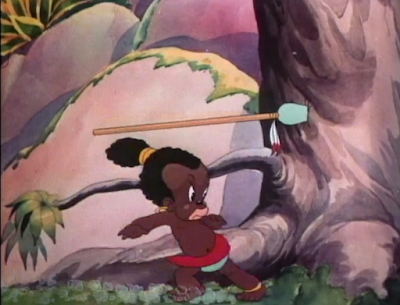





































































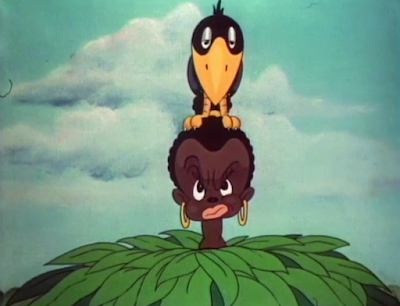
















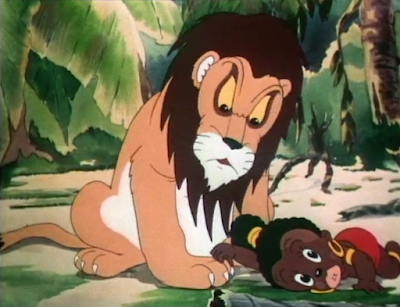
.gif)



























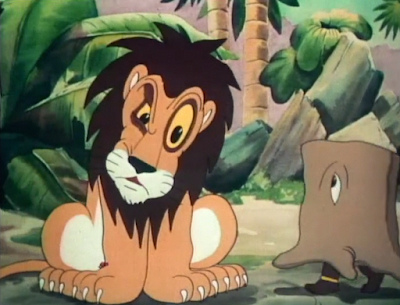
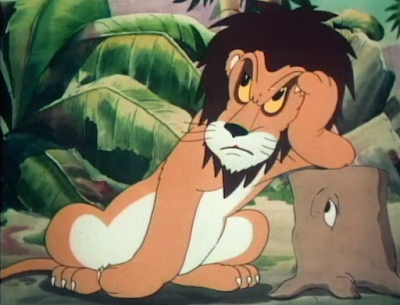





































No comments:
Post a Comment